So, I didn’t spend that long in South Africa, maybe a week in total, but I travelled across much of it from north to south. It’s a big country, and I pretty much only scratched the surface of it, but I’m sure I’ll be back. Consequently though, this means any overview posts I write about it will be purely my initial observations, and shouldn’t be taken as any kind of travel guide.
But let’s start at the beginning ….
Border Crossings
I experienced three border crossings in South Africa; the one from Lesotho back into SA deserves its own blog post, and I don’t really remember anything about the one entering Lesotho. The first one, from Zimbabwe, however, deserves a bit of a mention.
I’d caught a local minibus, packed to the rafters, from Mazvingo in Zimbabwe, which stuttered through the bushlands on the way to Beitbridge. Weirdly, the border crossing was not the last stop, and only a handful of people got off here.
Actually getting stamped out the country proved to be quite quick, but the process of getting there wasn’t. The Zimbabwean border point was a fairly chaotic mess, the main one being a complete lack of signage. Several buildings were scattered around, but with no indication what any of them were, nor was there any direction on where to go or what we needed to do. People milled around looking lost until it became clear a queue was forming from out of the doorway of one of the buildings. Even then it wasn’t exactly clear if this was the right queue, or if we needed to fill any paperwork in before leaving – the answer to this last point seeming to be ‘yes, but it depends on your nationality’.
Once I’d been stamped out it was then a long walk over a bridge across the Limpopo River to the South African border post. Structure-wise this was more organised, but it was still a very slow process. The main reason for this was the weird way they had of letting people in. There were several queues of people (maybe 8 or 10 in total), each leading to a border official sat in a small hut. I were assigned one and just waited my turn. Except it wasn’t quite as simple as that – not all the huts were open. A border guard would go into one, open up, processes a few people, then just stand up and leave, shutting the hut, regardless of the fact there was still a huge queue waiting. It took a while, maybe an hour or so, for a guard to even come to open the hut for my queue, and all the while I was waiting, I was thinking to myself ‘please don’t close, please don’t close’. Fortunately, they didn’t. For all I know, the queue of people next to me is still there, waiting for a border guard who never comes.
After that came a longer hut I had to go into to go through customs; the lady there wanted to make sure my computer was a tablet and not a laptop as I’d’ve had to pay a duty on bringing a laptop into the country, apparently. They seemed less concerned about what else I had in my bag to be honest though.
On the Zimbabwean side, there’s a small town. I was expecting the same to be true south of the river too, but no; the only thing on the South Africa side was a bus station and, across the main road and down a slight hill just out of visibility, a small shopping mall – the latter was fortunate as I didn’t have any South African Rand. By now it was getting towards evening and I had wanted to be somewhere before it got dark; as I didn’t know where I was going to be (and assuming Beitbridge existed in South Africa too), I hadn’t booked any accommodation anywhere. I ended up catching a share taxi to the next significant town to the south, Musina, where there was allegedly a backpacker hostel …
Accommodation
… it was fully dark by the time the taxi dropped me off in Musina, just outside what I was led to believe was a backpacker hostel. Bear in mind that I’d arrived here with no alternative plan, no map, and probably a rather overly-naive sense of myself. It didn’t look too hopeful; it looked locked up, with a huge solid metal sliding gate over the driveway, and no obvious intercom system. I knocked; nothing happened.
I lurked around a bit, knocking again. Then, with nothing to do with my presence whatsoever, someone came out to go shopping. He saw me, we had a chat, and he led me inside, saying ‘I think they’ve got a room, but I’m not sure’. Reader, he was right.

The main lounge of the Musina B&B. Kinda …studenty-but-functional-and-posher?
It was quite a strange place; it felt for all the world like a huge houseshare. The kitchen and lounge were one of the biggest I’d seen, especially given this was a hostel/B&B type place, and there were people around who had the air for all the world like they lived there rather than who just staying a couple of days. Granted Musina isn’t the sort of town you’d expect gets lots of tourists, but even so it was still quite an unusual feeling. My most notable memory was that on the TV, which no-one really seemed to be watching, was the South African version of ‘Come Dine With Me’, still narrated by Dave Lamb though.

The bedroom. So much space!
The room was equally large – two beds, a lot of space to wander around them, and more closet space than someone only travelling with hand luggage really knew what to do with. There was also an attached ensuite bathroom, and all for, what, £12/night or something. Definitely felt a cheap rate for what you got.
My next accommodation was a private room in a hostel in Pretoria. I wasn’t expecting to get a private room but I ended up being slotted into a thatched hut in the back garden, which was a much nicer set-up than a dorm. It had two beds in it but I was the only person in it for the whole time I was there.
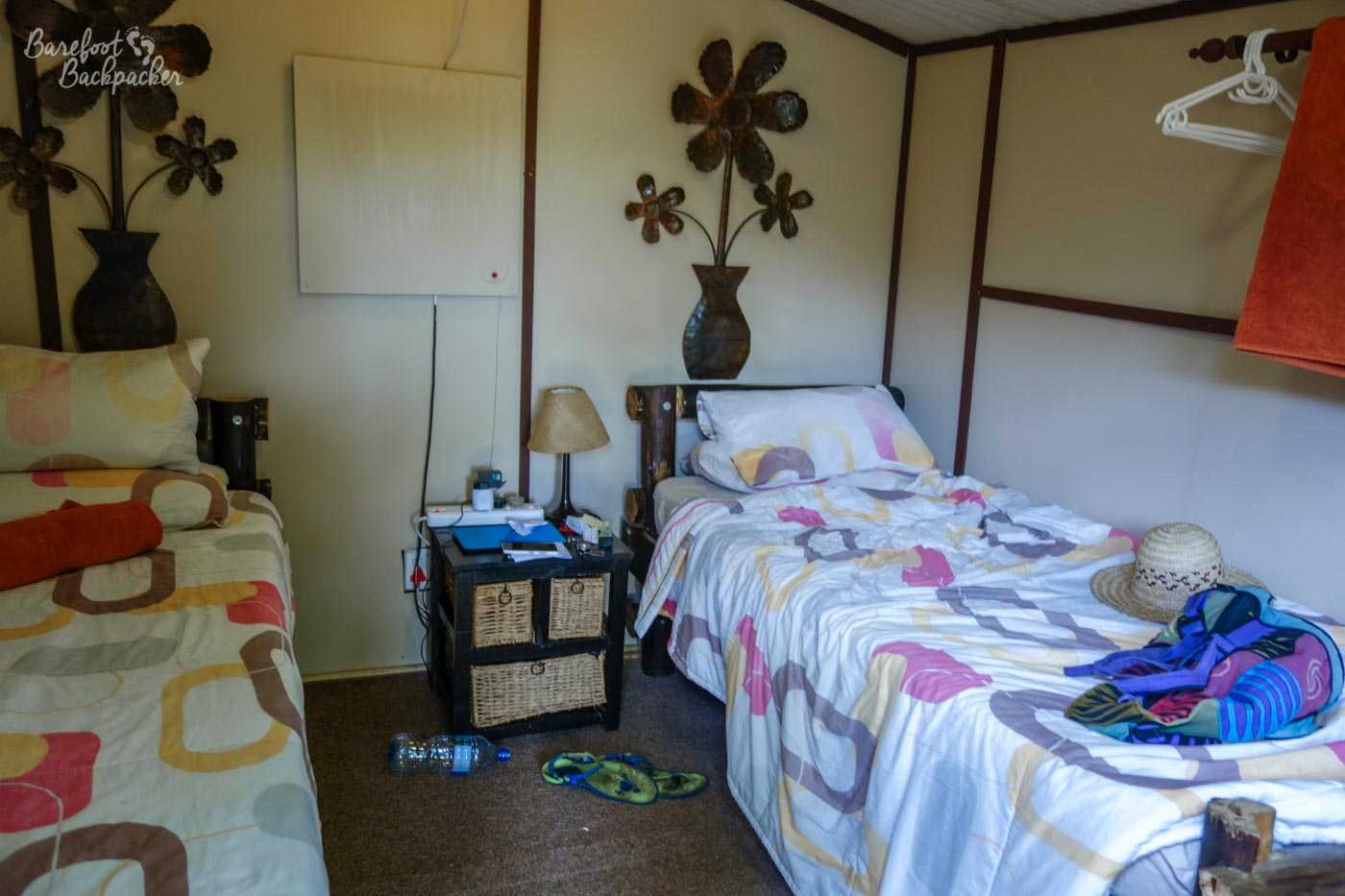
Inside the hut room in the Pretoria hostel. Comfortable.
It was a short walk from Hatfield Gautrain station, down a road that anywhere else would be seen as very middle-class. A quiet suburb, leafy streets, detached houses set well back from the pavement and quite well-hidden. The only thing that took the pleasantness away was the electric gates1 and huge walls, which in any other similar town in the world would be small wooden picket fences or low brick walls, and waist-high metal framework gates with ornamentation. It almost felt as if this was ‘the last bastion of respectability in a post-apocalyptic world’, but no, just White South Africa.
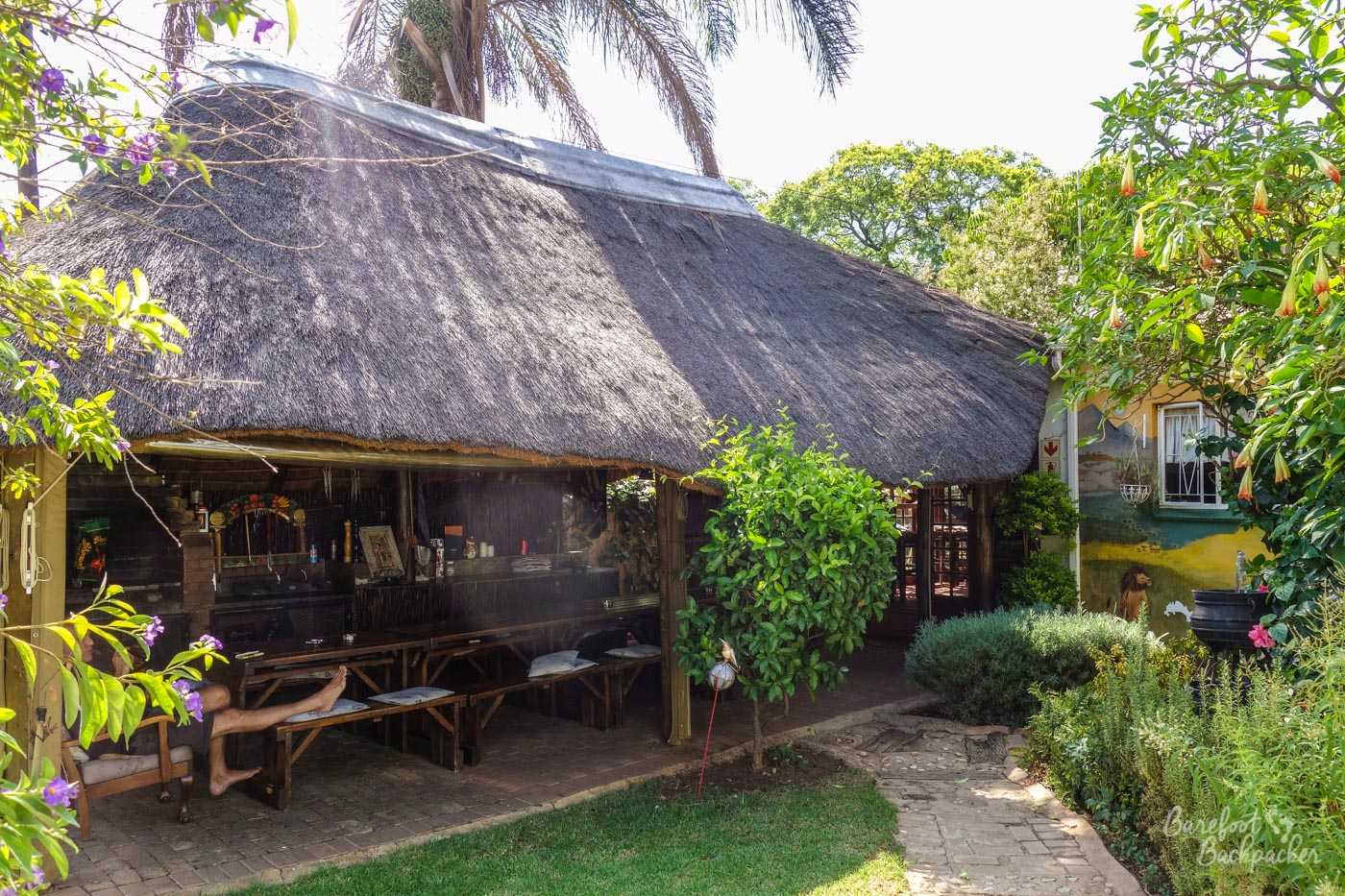
The outdoor dining area – braai at the back.
The hostel itself was grand though. A large kitchen, various places to socialise, a braai (which as you’ll see later got used), and the garden was full of small statues and other quirky objects. It even had a pool, which obviously I did not use. There was a pool in the hostel in Livingstone at the start of my journey too, which I also didn’t use save for obligatory paddling/feet-in-the-water selfies. Because my feet are vain. The decking by the braai was a good place to sit and watch the thunderstorm that passed through one evening too.
In Bloemfontein I had a room in a guesthouse a little way outside the city centre; I may have been the only person staying in it that night as the lady who ran it was asleep at the time of my arrival and didn’t hear the doorbell that I was ringing on the high wall outside the large metal gate outside, and I eventually had to phone her up instead. Being a shy retiring British chap who doesn’t like using the phone, I may have been waiting out there longer than most people would (an hour?!) just on the off-chance that they were not at home and I should wait for them to come back. But no, they were just asleep.
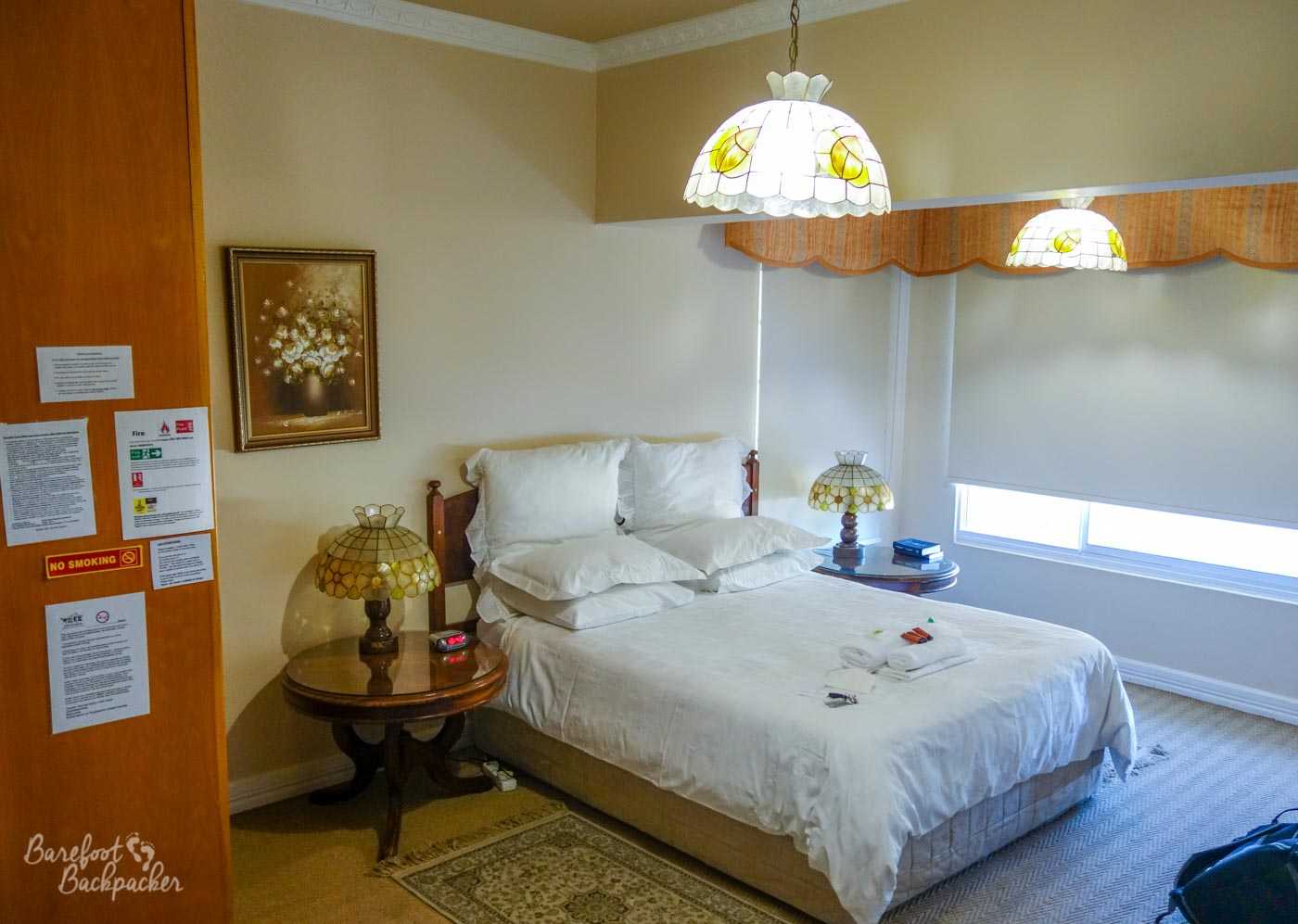
Traditional chic.
The room was lovely, if maybe with a slightly old-fashioned feel – not dissimilar to a British B&B. A nice double bed, plain but warm and homely décor, decent sized bathroom, and a balcony. Not that the view from it was particularly exciting – indeed it was so thrilling I never took a picture from it. Nicely spacious, and pretty quiet too. Restful.
This is one of the things the hostel (The Happy Hippo) I stayed in in Durban was not, though that wasn’t the fault of the hostel itself. It was recommended to me by Cee (of Ceeces Travel), so naturally I had to check it out. It was a great little place – colourful and stylish, with a very large communal area kitted out with motifs and design that felt like it represented an African safari, with wooden seating and associated artwork. The dorms fronted on to this communal area.
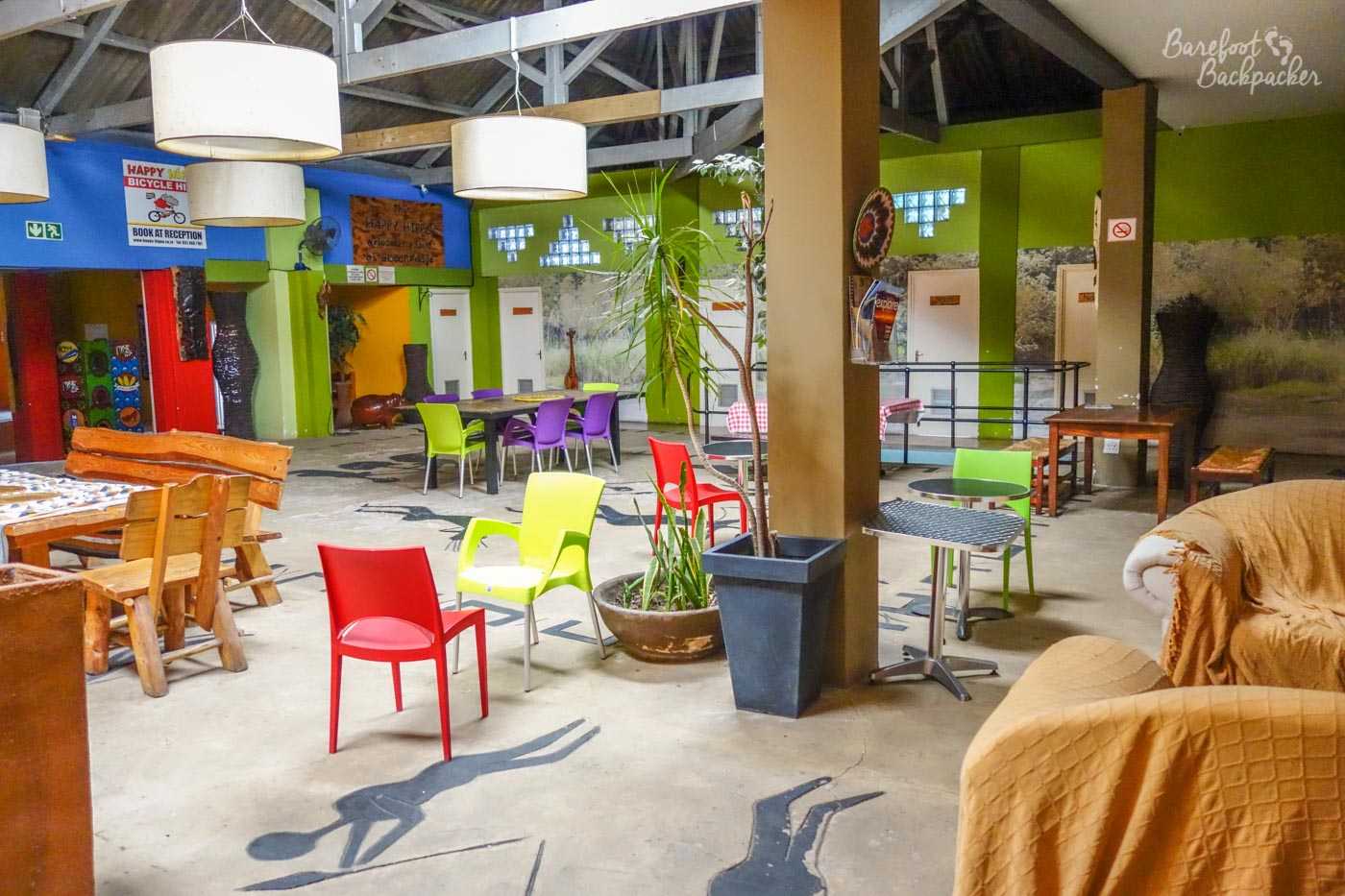
Minimalistic but vibrant and cool; I rather like this decor.
The rest of the hostel was equally expansive, with a bar room with a pool table and sound stage, and an upstairs outdoor balcony, plus a couple of smaller snug rooms to have quieter get-togethers.
While quite a walk from the local bus station, it was only a block or so away from the end of the beach, so in that respect it was a pretty convenient location, and I’d definitely stay there again.
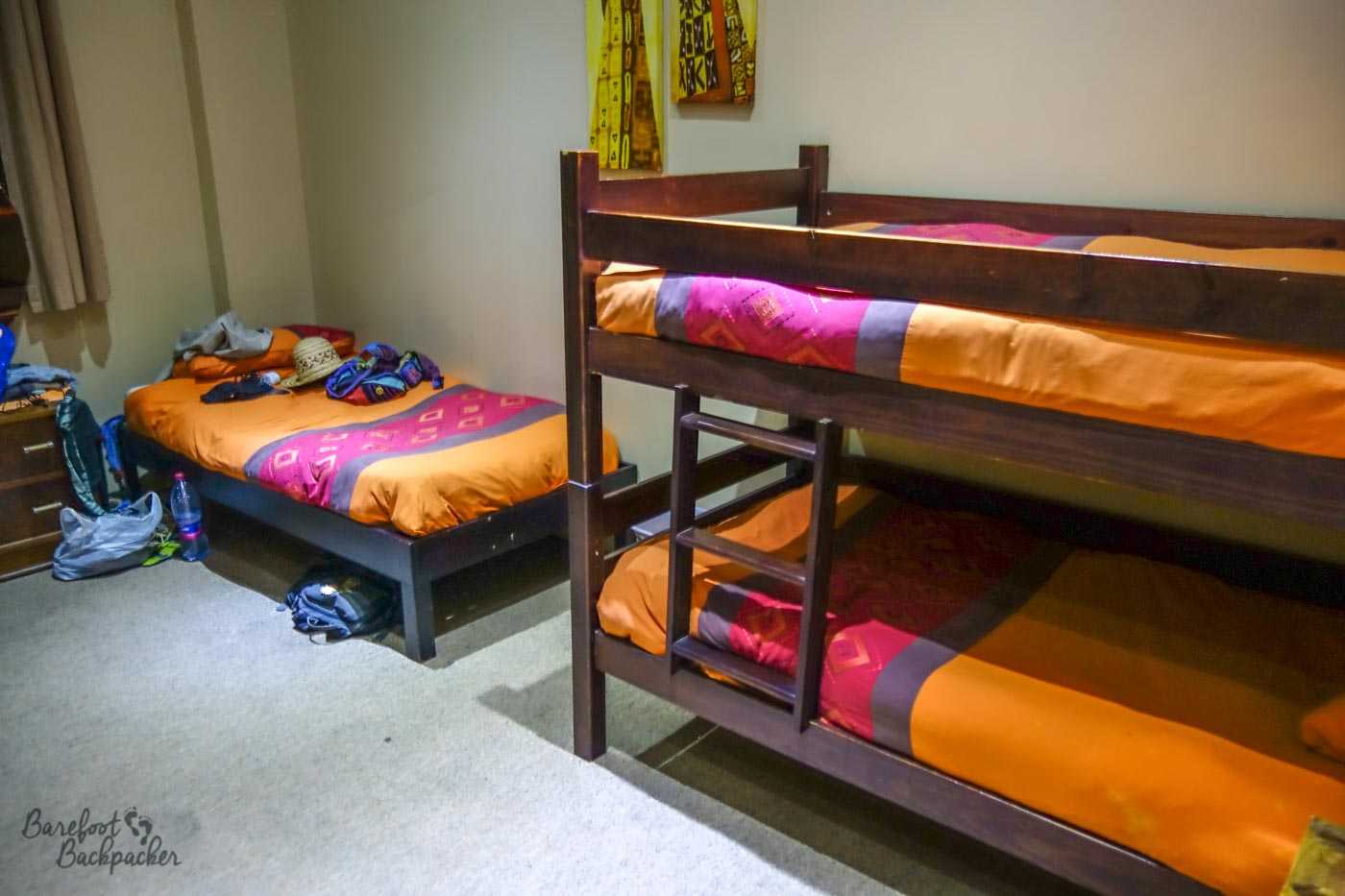
My dorm. Note the mix of bunk and solitary single bed.
I hope the Norwegian woman travelling single around Southern Africa with her 7-year-old son have continued to have a great time exploring the world and developing their knowledge. I am less hopeful though about the couple who may have been dating, or may have been using the hostel for some kind of illicit affair; it was hard to tell – from their accents, she sounded foreign while he had a much more local accent. What was not hard to tell was the fact that whatever they were doing wasn’t working. It was not the noise of their lovemaking that kept us all enthralled for the best part of three hours heading out towards midnight; rather, the complete opposite. A huge domestic fight, culminating in her locking him out of the private room they were sharing, and him banging on the door to be let back in. Both sides shouting their heads off. It’s a wonder the police weren’t called, to be honest.
Fortunately they were on the other side of the hostel from the dorm I was in, so if it continued throughout the night, I was none the wiser.
Transport
You might believe from some of things I’ve said above that South Africa is a very dangerous country, where people are going to rob and murder you on every street corner, where merely stepping out of your hotel is tantamount to walking around with a huge sign that says ‘I’m a foreigner, mug me’.
Nowhere is this more apparent than when discussing transport options. The minibuses are dangerous; full of opportunist thieves, and driven by crazy people. Don’t go near the bus stations – it’s a sure-fire way to be completely bamboozled and wake up in a bath of ice (I heard this specifically about Pretoria and especially Durban). Take taxis everywhere, even from your hotel to the restaurant, even if its a block away. Going between cities? Take a coach, or better yet, fly. You can afford it – don’t put a price on your life.
One thing, and one thing alone, connects all of these thoughts and beliefs. They’re generally held, and spoken, by white people.

Typical inter-city minibus in South Africa; this was in Musina.
I took several inter-city minibuses in South Africa. They were similar to the ones I took in West Africa, but with fewer people (i.e., approximately the correct number according to regulations), they left pretty frequently, and were a pretty good budget option. And, unlike West Africa, only one of them broke down; the bus from Pretoria to Bloemfontein had a small fault on the motorway not long after we started, which resulted in half the bus having to get off to lighten the load, the bus driving down a bit to a convenient place to stop and be repaired, and the passengers walking down the motorway and running across the carriageways twice to catch up. And you thought Frogger was just a video game.
Other minibuses I took were from Musina to Pretoria, Bloemfontein to Maseru, and Underberg to Durban. They were all pretty comfortable: easy to find, friendly service staff at the bus stations, convenient stops to pick up lunch, etc. They also tended to leave in good time – indeed on the bus to Maseru, the driver forbade anyone from getting off to buy food in the last few minutes before departure because he didn’t want to leave late.

A sign in Bloemfontein bus station that you would *never* have seen in Kumasi or Cotonou!
On all the buses, aside from one other person going to Maseru, I was the only white person. And you know, apart from a couple of people asking where I was from and where I was going, in the matter that I get everywhere of curious locals enquiring about the obvious foreigner, no-one really gave me a second glance. I’ll talk more about this in a subsequent blog post, but sometimes I think the fear of crime is far, far, more prevalent than crime itself.
An entire world away from the inter-city minibuses is the Gautrain – the quick and flash suburban rail line that connects Pretoria with Johannesburg, with a side branch to Oliver Tambo Airport. My hostel was a convenient half-street away from the Hatfield Gautrain stop, which made it a pretty easy way to get into Pretoria city centre.
It was built in the second half of the 2000s, in preparation for the FIFA Men’s Football World Cup, and … it certainly does have the feel of a slightly more affluent experience than a simple commuter train would – it’s more like the Heathrow Express than the London Overground. In fact this is one of the criticisms levelled at it; that it’s a white man’s train that connects white man’s places and doesn’t actually serve any of the parts of the region that have the most road traffic.
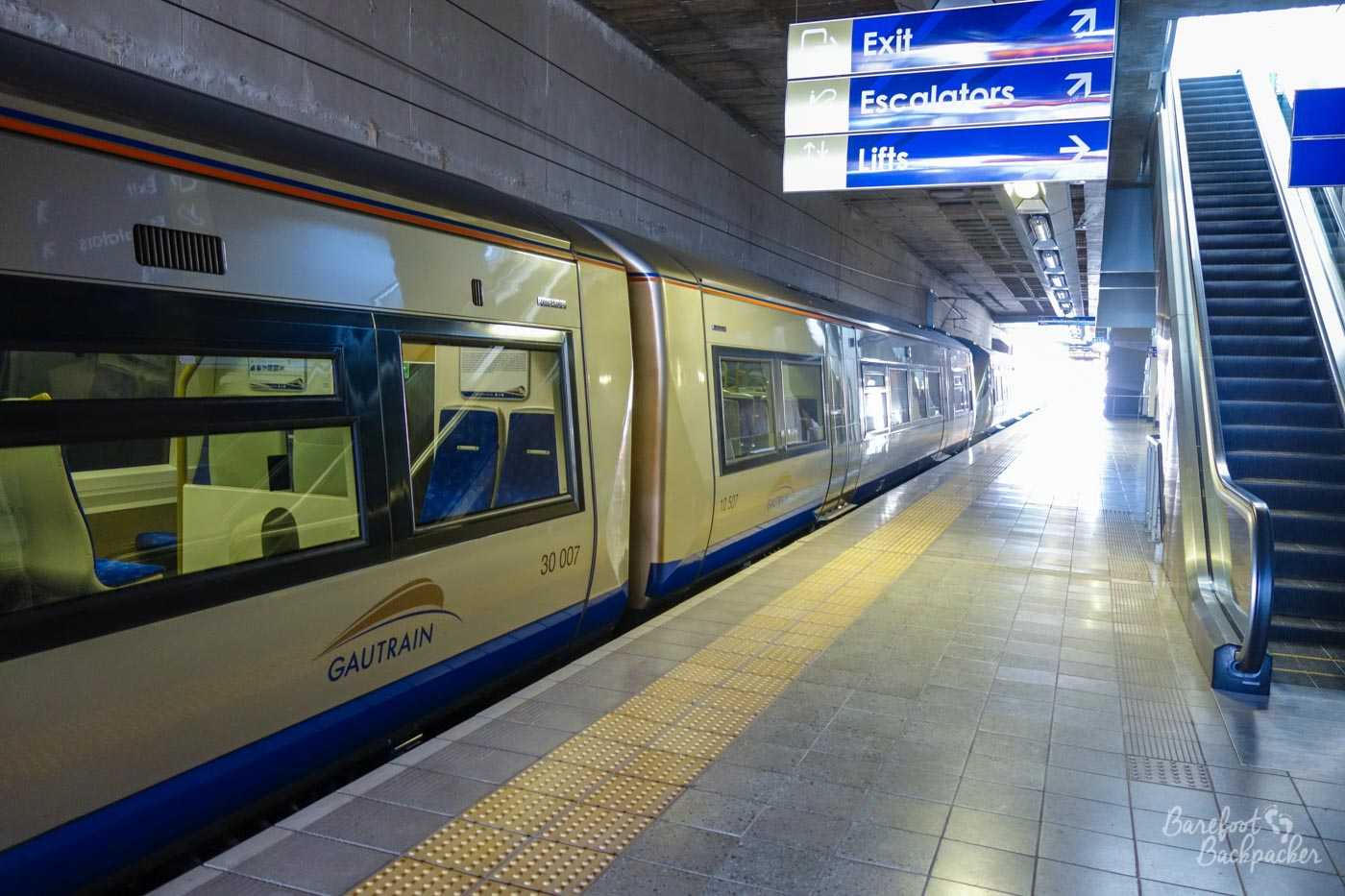
The Gautrain, at the station.
The first things I noticed when I first stepped inside one of the carriages were the sleek chrome finish, the rather large space inside, and the fact there were about four people in the carriage. Very quickly afterwards I noticed the temperature inside.
It’s a bit like riding a fridge on rails.
Now, this might have been because it was so hot outside (temperatures outside were estimated to be hitting 40°C), but it was by far and away the coldest place I’d experience on the whole of my Southern Africa adventure. At first it was lovely to get inside and escape from the hot sun for once, but after a while you felt like you needed a coat.
Food
The first thing I realised about South Africa was how cheap it was while I was there, compared with neighbouring countries. As an example, in Zimbabwe I was generally getting a 500ml bottle of water for $1. For 12 Rand, or just less than $1, I bought a bottle double that size in Pretoria.
For my long bus journeys I tended to survive on biltong. Now I’m sure you all know what biltong is, and indeed it’s so ubiquitous I seem to have not taken any pictures of it (!), but if not, I’ll now try to describe it to you without making you think ‘…why?’. It’s similar to (beef) jerky, although made with different spices and, let’s be honest, meats – it’s basically strips of your favourite dead animal (this is Southern Africa, so while beef is incredibly common, the Brit in me is more taken with the springbok, ostrich, or kudu biltong), spiced in coriander and salt, and dry-cured.
It’s quite chewy and does not resemble flavoured cardboard. Not in the slightest.
Speaking of weird and wonderful meats to the British palate, in my hostel in Pretoria I took part in a braai. I mean, it’s simply a barbecue, it’s nothing completely extraordinary, except that it does seem to be one of those stereotypes that people have about South Africans; rather than, say, English people having a barbecue because it’s a sunny day and the football’s on and they want to have people over, the South Africans are felt to organise the braai first and worry about the whys and wherefores later.
In this particular case, the lady who ran the hostel took me to the supermarket, we bought stuff for the braai, and ate it later – showing the communal feel of the event. All I need do to pay her back is to … visit the hostel again on my next trip to South Africa. I mean, I intend to, but I just haven’t made it back there yet … !
The most local food I had in South Africa though was the Bunny Chow in Durban. It is, essentially, curry inside a loaf of bread.
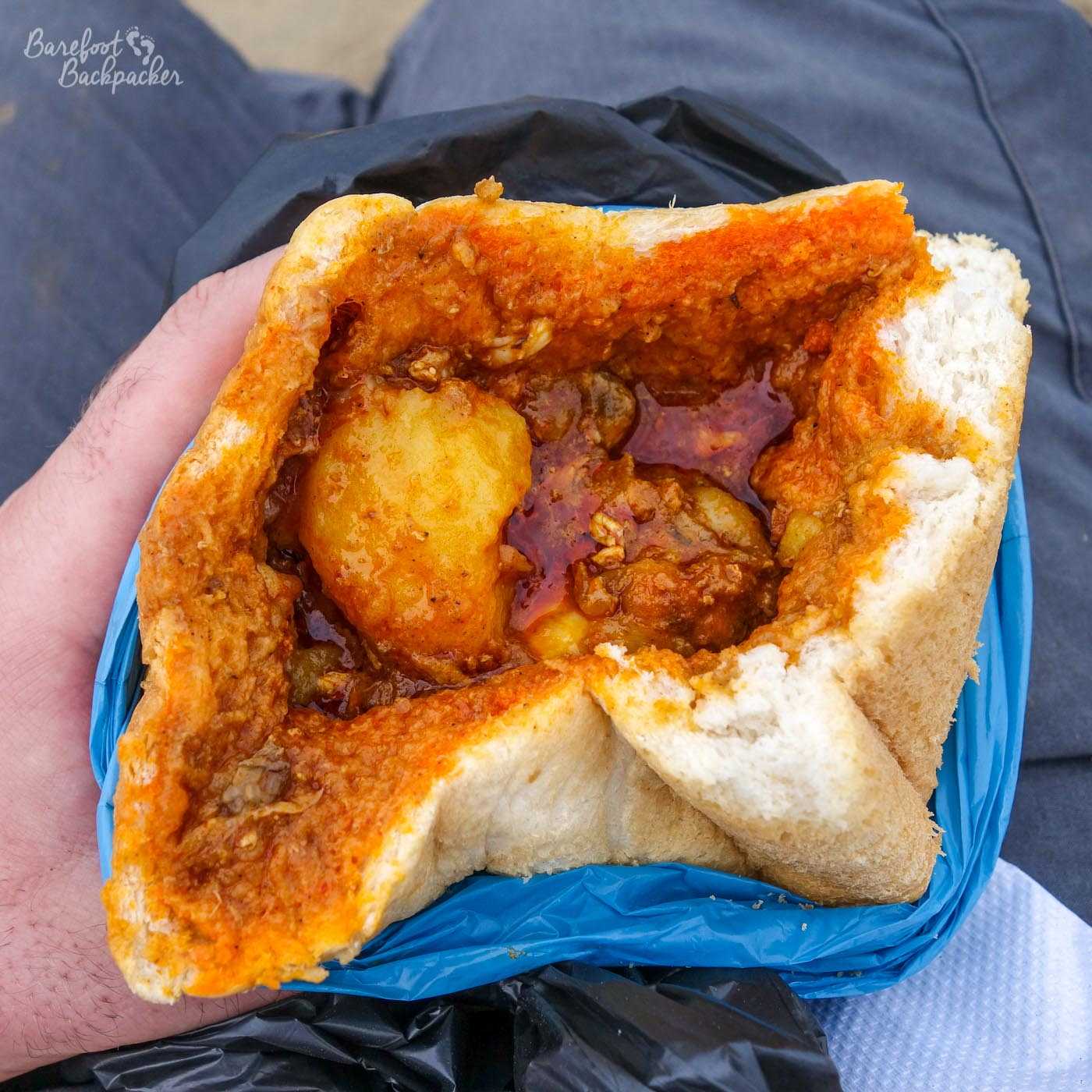
Bunny Chow, opened and ready to eat.
It developed from food created by Indian immigrants, and consists of an unsliced loaf of bread (of variety of sizes, though the quarter or half loaves are the most common), hollowed out and filled with curry – traditionally vegetarian, though meat variations do exist. Whether that includes ostrich or not I don’t know. Often, the hollowed-out bit of bread is placed on the top of the filled loaf.
One belief as to why it exists is because traditional Indian breads didn’t last as long (in terms of structural integrity) when the curry was added (as opposed to being served separately), and the point was to have a foodstuff that could last until lunchtime and be eaten pretty easily, in small eating situations, possibly not even sat down. A loaf of bread, with thick crusts, would soak up the curry sauces without becoming too sodden and limp.
Towns and Cities
My first stop in South Africa was a brief overnight stay in Musina. I didn’t get to explore much of the town, as I arrived in darkness and headed out early the next morning. However what I did see reminded me a little of West Africa, though maybe with less colour & flair. The shops seemed more like shacks by the side of the road, the roads themselves felt a little unkempt, and there was a slight air of more people living below the poverty line than in other places I’d been on this trip.
I wasn’t overly impressed with Pretoria, I have to say. With its dirty streets and mishmash of corporate buildings next to bedraggled ones, the centre of the city felt like some dodgy inner city in the USA (the statue of Paul Kruger in the main square is protected by barbed wire, like something out of a post-revolutionary police state – he suffers from a similar colonial backstory to Cecil Rhodes). I also didn’t find the people as welcoming as I’d grown used to further north – in quiet suburban streets you’d still get a ‘hello’ but in the centre of town everyone looked mean and miserable – a far cry from Zambia & Zimbabwe where people seemed pleased to see each other.
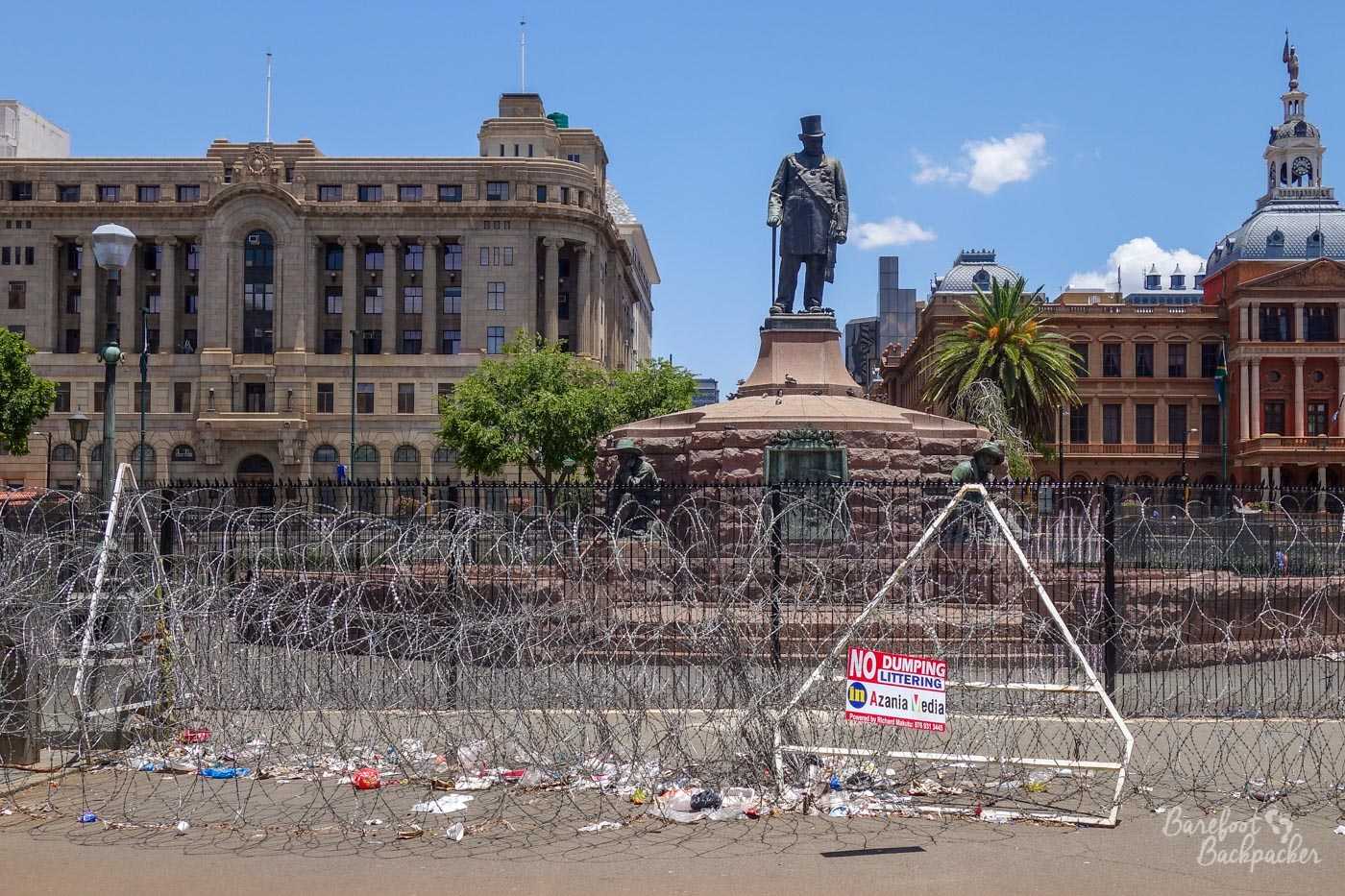
Paul Kruger statue, central Pretoria. Looks … appealing!
That said, it was home to quite a decent regional-history museum – the National Cultural History Museum. It took you through a history and overview of the culture of the San people whose native area this is, passed through a few historical relics, and then gave a brief overview of Marabastad, a suburb of Pretoria and now largely a business district but was once home to a thriving and diverse community who were relocated as a result of apartheid legislation.
As for nearby Johannesburg, I didn’t spend that long in it; merely a couple of hours passing through on a group tour on the way back from the more notable town(ship) of Soweto. Most of it I saw through the window of a minibus; it rained a lot and the city felt quite … grey, slightly dour and unloved. We were taken up a large tower to take a look at the city sprawled out below us; this may have been a slightly ugly building known as the Carlton Centre (colloquially known as the ‘Top Of Africa’) which, if so, was at the time of my visit the tallest building in Africa (at 223m) – a nearby mixed residential/business building (The Leonardo) in Jo’burg was completed in 2019 and is 11m taller. Note for British residents; if the Carlton Centre were in London it would be (as of April 2020) the 7th tallest building, a couple of metres shy of 122 Leadenhall Street (‘The Cheesegrater’). The Leonardo, the tallest building in Africa, is 1m shorter than One Canada Square, the tallest building in Canary Wharf.
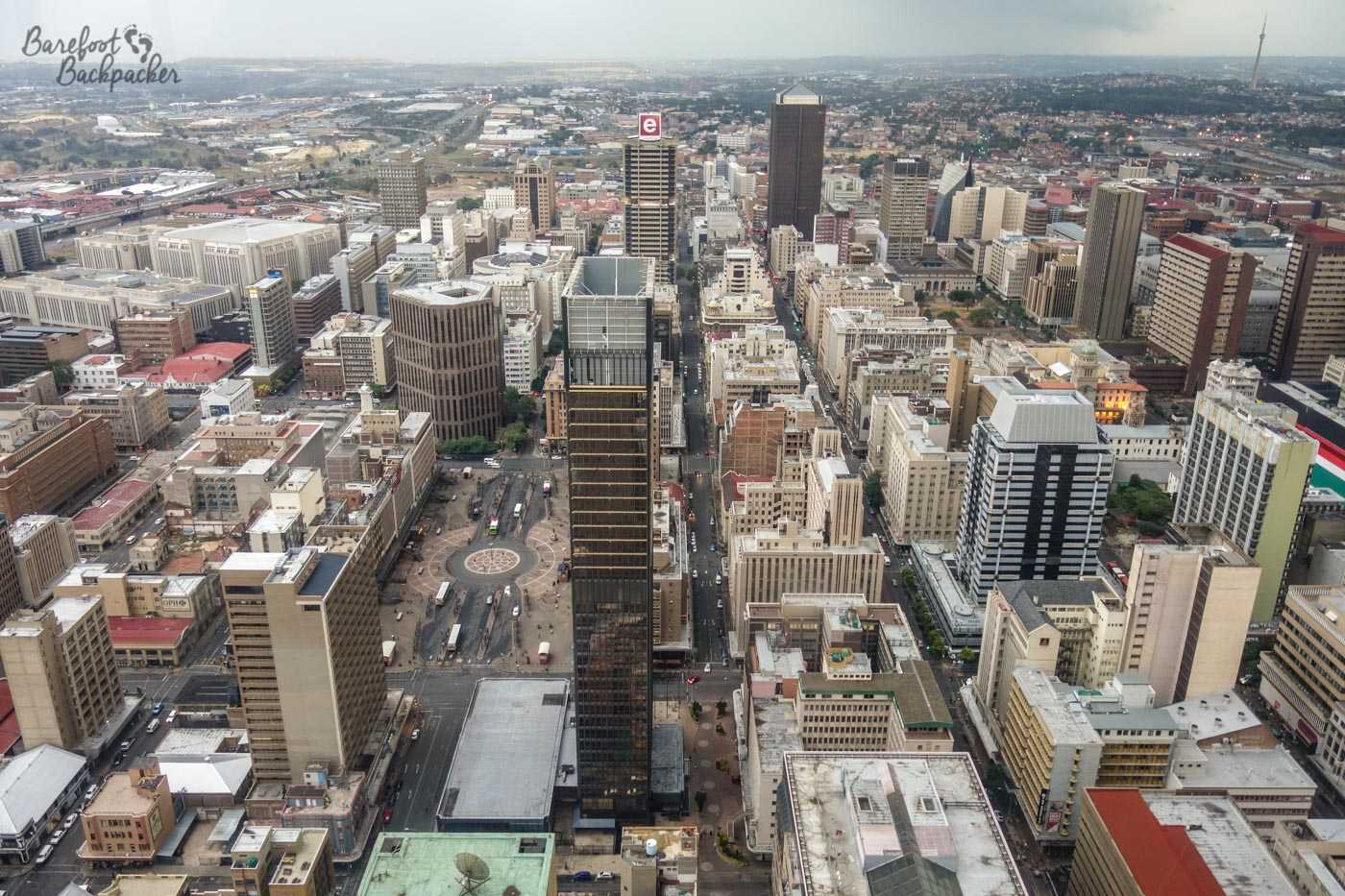
View across Johannesburg from the Top Of Africa.
[Side caveat, before people raise the point. The tallest structure in Africa is the minaret for the Djamaa el Djazaïr mosque in Algiers. In the same way the tallest structure in Europe is a radio mast in Moscow. Not a building. Don’t be pedantic.]

The main square in the centre of Bloemfontein .
Although I spent some longer in Bloemfontein, much of that was in my guesthouse, I arrived around 3pm and headed off mid-morning the next day, so I used it more as an overnight stopover than to look around the place more than just a casual wander. Like Pretoria (and the unvisited Cape Town, but not Johannesburg despite it being the largest city) it’s one of the official capitals of the country. My brief impressions though were of a small country town, belied by the fact when looking up its stats for this blog, it has a similar population to that of Sheffield.
I spent a few hours longer in Durban, though the majority of that was wandering up and down the beach. I guess this is what Durban is most noted for – and to be fair it is quite an expansive and busy stretch of sand; there’s scope for watersports, paddling, or playing life-size chess pieces. There’s also a theme park on the promenade, but obviously that’s not something I had much truck with.
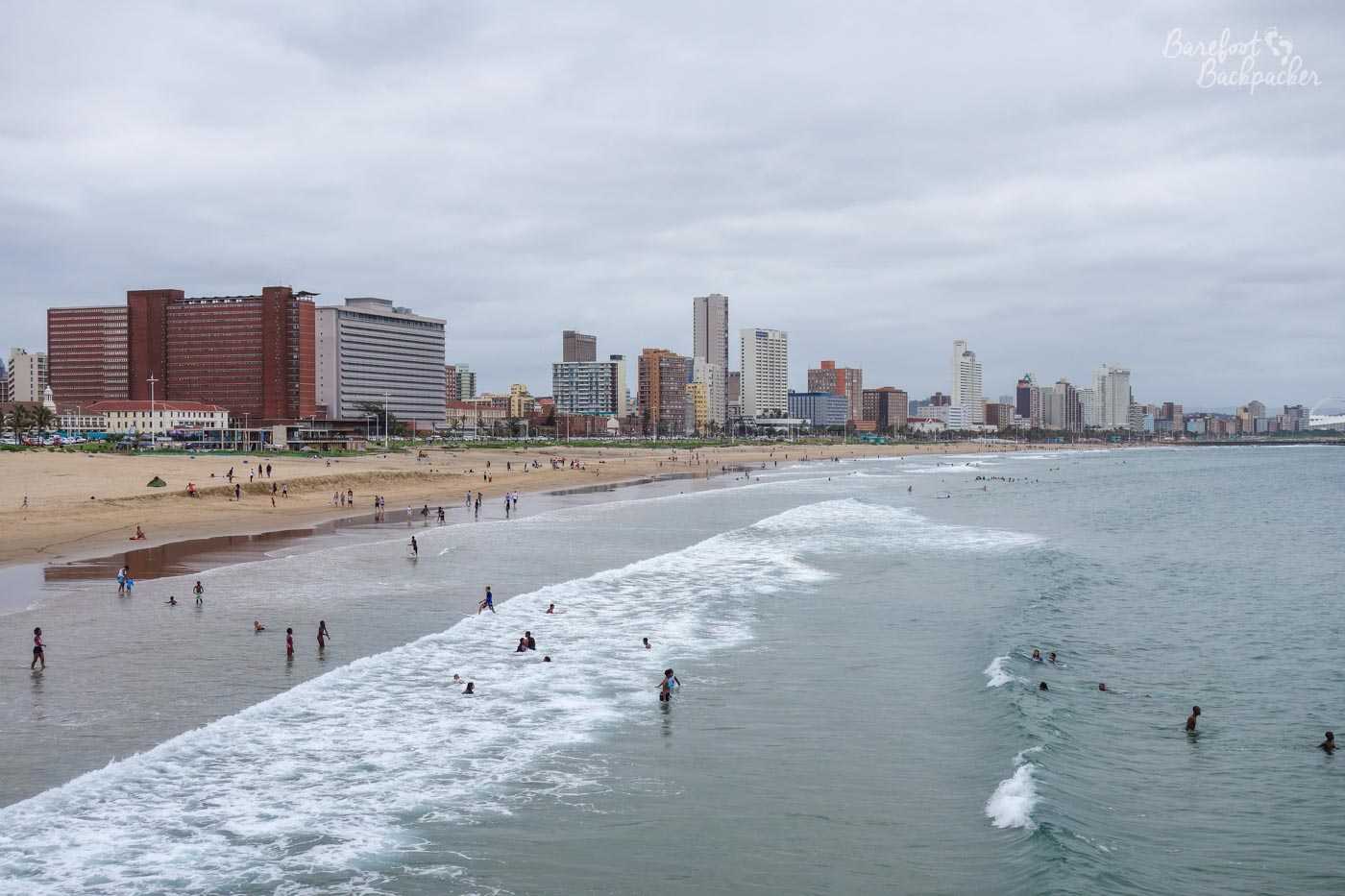
Durban’s beach.
One thing I did notice in Durban was a fair array of street art, some of it very well designed.
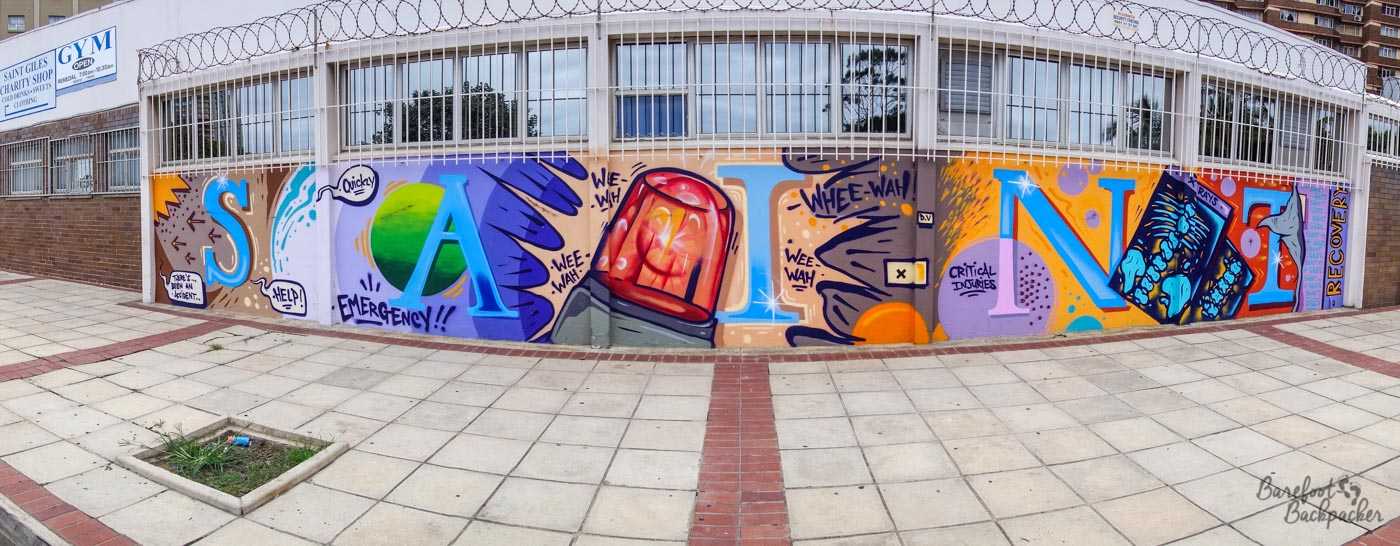
Some street art in Durban.
The Weather
I went in Summer. It was feckin’ hot, with thunderstorms later.

Newspaper poster suggesting the weather was going to be hot.
—
Like this post? Pin it?
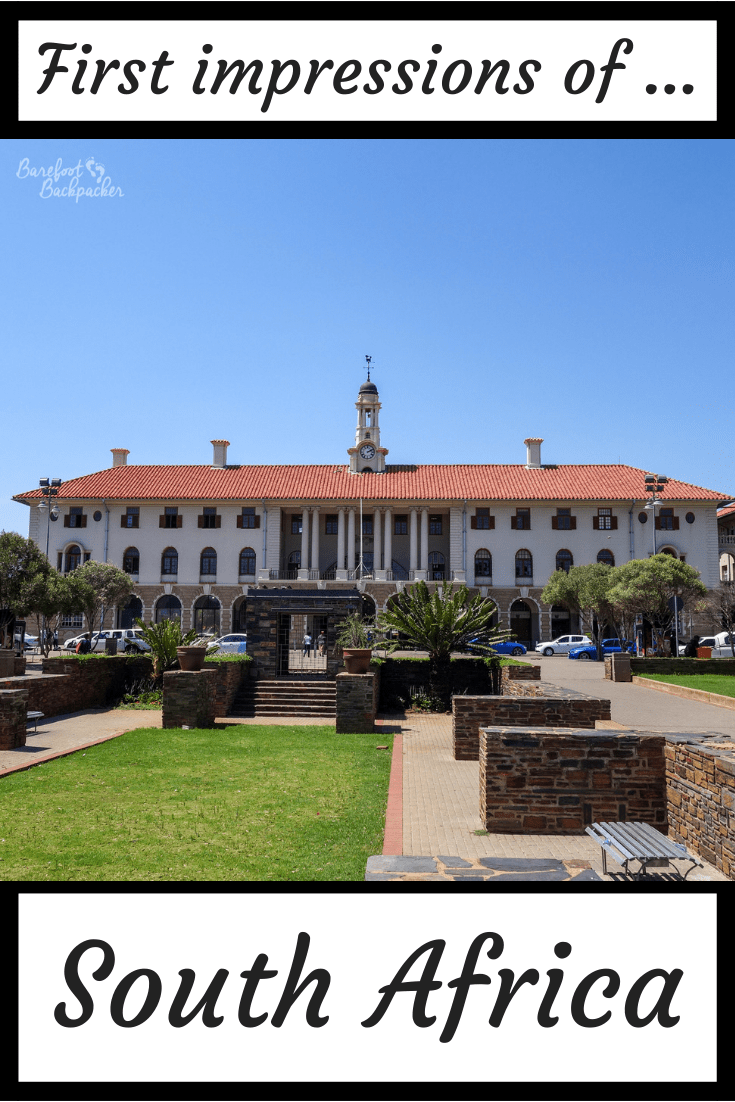
Visited: 6-11 and 16-17 January 2016
Mmmm, bunny chows, such a good idea. They’re usually the first thing that comes to mind when I think of Durban.